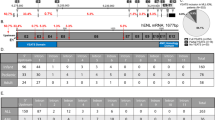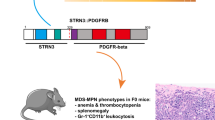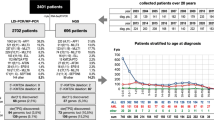Abstract
We have identified a new mixed lineage leukemia (MLL) gene fusion partner in a patient with treatment-related acute myeloid leukemia (AML) presenting a t(2;11)(q37;q23) as the only cytogenetic abnormality. Fluorescence in situ hybridization demonstrated a rearrangement of the MLL gene and molecular genetic analyses identified a septin family gene, SEPT2, located on chromosome 2q37, as the fusion partner of MLL. RNA and DNA analyses showed the existence of an in-frame fusion of MLL exon 7 with SEPT2 exon 3, with the genomic breakpoints located in intron 7 and 2 of MLL and SEPT2, respectively. Search for DNA sequence motifs revealed the existence of two sequences with 94.4% homology with the topoisomerase II consensus cleavage site in MLL intron 7 and SEPT2 intron 2. SEPT2 is the fifth septin family gene fused with MLL, making this gene family the most frequently involved in MLL-related AML (about 10% of all known fusion partners). The protein encoded by SEPT2 is highly homologous to septins 1, 4 and 5 and is involved in the coordination of several key steps of mitosis. Further studies are warranted to understand why the septin protein family is particularly involved in the pathogenesis of MLL-associated leukemia.
This is a preview of subscription content, access via your institution
Access options
Subscribe to this journal
Receive 50 print issues and online access
$259.00 per year
only $5.18 per issue
Buy this article
- Purchase on Springer Link
- Instant access to full article PDF
Prices may be subject to local taxes which are calculated during checkout



Similar content being viewed by others
Accession codes
References
Abeysinghe SS, Chuzhanova N, Krawczak M, Ball EV, Cooper DN . (2003). Hum Mutat 22: 229–244.
Berger R, Flandrin G, Bernheim A, Le Coniat M, Vecchione D, Pacot A et al. (1987). Cancer Genet Cytogenet 29: 9–21.
Borkhardt A, Bojesen S, Haas OA, Fuchs U, Bartelheimer D, Loncarevic IF et al. (2000). Proc Natl Acad Sci USA 97: 9168–9173.
Chinwalla V, Chien A, Odero M, Neilly MB, Zeleznik-Le NJ, Rowley JD . (2003). Oncogene 22: 1400–1410.
Chuzhanova N, Abeysinghe SS, Krawczak M, Cooper DN . (2003). Hum Mutat 22: 245–251.
Daser A, Rabbitts TH . (2005). Semin Cancer Biol 15: 175–188.
DeLozier-Blanchet CD, Cabrol C, Werner-Favre C, Beris P, Engel E . (1985). Cancer Genet Cytogenet 16: 95–102.
Fischer K, Frohling S, Scherer SW, McAllister Brown J, Scholl C, Stilgenbauer S et al. (1997). Blood 89: 2036–2041.
Fuchs U, Rehkamp G, Haas OA, Slany R, Konig M, Bojesen S et al. (2001). Proc Natl Acad Sci USA 98: 8756–8761.
Grier DG, Thompson A, Kwasniewska A, McGonigle GJ, Halliday HL, Lappin TR . (2005). J Pathol 205: 154–171.
Gu Y, Nakamura T, Alder H, Prasad R, Canaani O, Cimino G et al. (1992). Cell 71: 701–708.
Hall PA, Russell SE . (2004). J Pathol 204: 489–505.
Harrison CJ, Cuneo A, Clark R, Johansson B, Lafage-Pochitaloff M, Mugneret F et al. (1998). Leukemia 12: 811–822.
Hayette S, Tigaud I, Vanier A, Martel S, Corbo L, Charrin C et al. (2000). Oncogene 19: 4446–4450.
Huret JL . (2005). Atlas of Genetics and Cytogenetics in Oncology and Haematology http://www.infobiogen.fr/services/chromcancer/Genes/MLL.html.
Ida K, Kitabayashi I, Taki T, Taniwaki M, Noro K, Yamamoto M et al. (1997). Blood 90: 4699–4704.
ISCN (1995). An International System for Human Cytogenetic Nomenclature. Karger: Basel.
Kinoshita M, Kumar S, Mizoguchi A, Ide C, Kinoshita A, Haraguchi T et al. (1997). Genes Dev 11: 1535–1547.
Kojima K, Sakai I, Hasegawa A, Niiya H, Azuma T, Matsuo Y et al. (2004). Leukemia 18: 998–1005.
Kourlas PJ, Strout MP, Becknell B, Veronese ML, Croce CM, Theil KS et al. (2000). Proc Natl Acad Sci USA 97: 2145–2150.
Li ZY, Liu DP, Liang CC . (2005). Leukemia 19: 183–190.
Marosi C, Koller U, Koller-Weber E, Schwarzinger I, Schneider B, Jager U et al. (1992). Cancer Genet Cytogenet 61: 14–25.
Megonigal MD, Rappaport EF, Jones DH, Williams TM, Lovett BD, Kelly KM et al. (1998). Proc Natl Acad Sci USA 95: 6413–6418.
Milne TA, Briggs SD, Brock HW, Martin ME, Gibbs D, Allis CD et al. (2002). Mol Cell 10: 1107–1117.
Nakamura T, Mori T, Tada S, Krajewski W, Rozovskaia T, Wassell R et al. (2002). Mol Cell 10: 1119–1128.
Ono R, Nakajima H, Ozaki K, Kumagai H, Kawashima T, Taki T et al. (2005). J Clin Invest 115: 919–929.
Ono R, Taki T, Taketani T, Kawaguchi H, Taniwaki M, Okamura T et al. (2002). Cancer Res 62: 333–337.
Osaka M, Rowley JD, Zeleznik-Le NJ . (1999). Proc Natl Acad Sci USA 96: 6428–6433.
Poirel H, Rack K, Delabesse E, Radford-Weiss I, Troussard X, Debert C et al. (1996). Blood 87: 2496–2505.
Popovic R, Zeleznik-Le NJ . (2005). J Cell Biochem 95: 234–242.
Prasad R, Leshkowitz D, Gu Y, Alder H, Nakamura T, Saito H et al. (1994). Proc Natl Acad Sci USA 91: 8107–8111.
Pui CH, Relling MV . (2000). Br J Haematol 109: 13–23.
Rasmussen SW . (2004). SEQ Tools Version 8.2 – Build 101 http://www.seqtools.dk.
Rudiger NS, Gregersen N, Kielland-Brandt MC . (1995). Nucleic Acids Res 23: 256–260.
Russell SE, Hall PA . (2005). Br J Cancer 93: 499–503.
Satake N, Maseki N, Nishiyama M, Kobayashi H, Sakurai M, Inaba H et al. (1999). Leukemia 13: 1013–1017.
Savage PD, Shapiro M, Langdon WY, Geurts van Kessel AD, Seuanez HN, Akao Y et al. (1991). Cytogenet Cell Genet 56: 112–115.
Slany RK . (2005). Hematol Oncol 23: 1–9.
Smit AFA, Hubley R, Green P . (2004). RepeatMasker Open-3.0 http://www.repeatmasker.org.
So CW, Caldas C, Liu MM, Chen SJ, Huang QH, Gu LJ et al. (1997). Proc Natl Acad Sci USA 94: 2563–2568.
Sobulo OM, Borrow J, Tomek R, Reshmi S, Harden A, Schlegelberger B et al. (1997). Proc Natl Acad Sci USA 94: 8732–8737.
Spiliotis ET, Kinoshita M, Nelson WJ . (2005). Science 307: 1781–1785.
Strehl S, Borkhardt A, Slany R, Fuchs UE, Konig M, Haas OA . (2003). Oncogene 22: 157–160.
Surka MC, Tsang CW, Trimble WS . (2002). Mol Biol Cell 13: 353235–353245.
Taki T, Kano H, Taniwaki M, Sako M, Yanagisawa M, Hayashi Y . (1999b). Proc Natl Acad Sci USA 96: 14535–14540.
Taki T, Ohnishi H, Shinohara K, Sako M, Bessho F, Yanagisawa M et al. (1999a). Cancer Res 59: 4261–4265.
Taki T, Sako M, Tsuchida M, Hayashi Y . (1997). Blood 89: 3945–3950.
Tkachuk DC, Kohler S, Cleary ML . (1992). Cell 71: 691–700.
von Bergh AR, Wijers PM, Groot AJ, van Zelderen-Bhola S, Falkenburg JH, Kluin PM et al. (2004). Genes Chromosomes Cancer 39: 324–334.
Winick NJ, McKenna RW, Shuster JJ, Schneider NR, Borowitz MJ, Bowman WP et al. (1993). J Clin Oncol 11: 209–217.
Yamamoto K, Seto M, Iida S, Komatsu H, Kamada N, Kojima S et al. (1994). Blood 83: 2912–2921.
Acknowledgements
This research was supported by Liga Portuguesa Contra o Cancro – Núcleo Regional do Norte.
Author information
Authors and Affiliations
Corresponding author
Rights and permissions
About this article
Cite this article
Cerveira, N., Correia, C., Bizarro, S. et al. SEPT2 is a new fusion partner of MLL in acute myeloid leukemia with t(2;11)(q37;q23). Oncogene 25, 6147–6152 (2006). https://doi.org/10.1038/sj.onc.1209626
Received:
Revised:
Accepted:
Published:
Issue Date:
DOI: https://doi.org/10.1038/sj.onc.1209626
Keywords
This article is cited by
-
Both SEPT2 and MLL are down-regulated in MLL-SEPT2therapy-related myeloid neoplasia
BMC Cancer (2009)
-
A variant-type MLL/SEPT9 fusion transcript in adult de novo acute monocytic leukemia (M5b) with t(11;17)(q23;q25)
International Journal of Hematology (2008)
-
Characterization of a SEPT9 interacting protein, SEPT14, a novel testis-specific septin
Mammalian Genome (2007)



